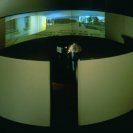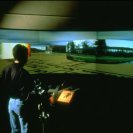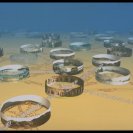The installation has a large cylindrical projection screen with a round motorised platform in its centre, a computer and three video projectors that project onto a 120-degree portion of the screen. Continuous rotation of this viewing window around the screen reveals the full 360-degree computer-generated scene. While the work is controlled and generally viewed from within the circumference of the screen, the projected image can also be seen on its outside surface.
The user interface in this work is a modified video camera. By rotating this camera and using its zoom and play buttons, the viewer controls his forward, backward and rotational movements through the virtual scene as well as the rotation of the platform and of the projected image around the circular screen.
The projected scenery is constituted by eleven cylinders showing landscape photographs taken by a special panoramic camera in various locations - Australia, Japan, La Palma, Bali, France, Germany, etc. Each of these virtual panoramic cylinders in the computer-generated landscape has the same height and diameter as the projection screen, so that when locating himself at the centre of these pictures the viewer can completely reconstitute the original 360-degree camera view on the screen. In this way the work locates the panoramic imagery in an architectonic framework that correlates the design of the virtual landscape with that of the installation itself, so making the virtual and actual spaces co-active on many levels of signification.
The ground surface on which these panoramas are positioned is marked by a diagram of the Sephirothic 'Tree of Life'. The placement of each panorama connects the visual identity of its scenery with the connotation of its symbolic location. The viewfinder on the interface camera shows an aerial view of this diagram, interactively centred on the viewer's actual position in the landscape.
A microphone on top of the interface camera picks up any sound that the viewer makes and this controls the release of travelling three-dimensional texts within the projected scene. Quoted from various sources, these texts offer a discourse around issues of place and language. Whilst the letters originate in the centre of the screen, their physical arrangement in the virtual space is dynamically determined by the viewer's movements. After some minutes these letters become more and more transparent until they disappear, forming a trace of something said that temporarily marks each viewer's presence in this work.
Credit:
Software: Adolf Mathias
Hardware: Huib Nelissen and Bas Bossinade
2-D graphics: Tamas Waliczky
Consultant: Rufus Camphausen
Produced under the auspices of the Neue Galerie am Landesmuseum Joanneum, Graz, Austria in cooperation with Stiftung Kulturfonds, Berlin, Germany and the ZKM, Karlsruhe, Germany
Exhibitions:
1995: Trigon-Personale 95, Neue Galerie am Landesmuseum Joanneum, Graz, Austria.
1996: Under Capricorn, Stedelijk Museum, Amsterdam, Netherlands; Artifices 4, Saint-Denis, France; La Villette, Cité des Sciences et de l´Industrie, Paris, France.
1997: Virtual Art - Plural Reality, Museo de Monterrey, Monterrey, Mexico.
1998: surrogate 1, ZKM, Karlsruhe, Germany.
1999: City Gallery, Wellington, New Zealand.









